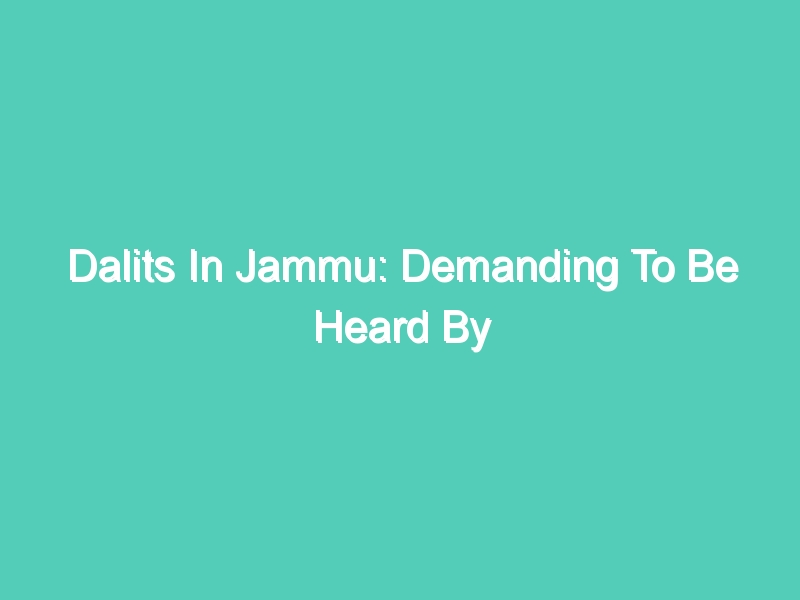Dalits account for almost a tenth of the population of Jammu and Kashmir or about a third of the population of Jammu province, but in discussions about the Kashmir question the Dalit voice is almost completely absent. Typically, the Hindus of the state are treated as a homogenous whole, although sometimes a distinction is made between the Pundits of the Valley and the Dogras of Jammu. It is, however, crucial to bring in the Dalit perspective when examining inter-community relations in Jammu and Kashmir, not only because of the numerical importance of the Dalits but also because they are among the most marginalised communities in the state.
There are 13 Scheduled Castes in Jammu and Kashmir, and the state’s Dalit population is almost entirely concentrated in the Jammu province. In addition to the Dalits who are counted as Hindus are numerous Dalit groups who have converted to Sikhism, Christianity and Islam. According to T.R. Azad, a leading Ambedkarite activist from Jammu, historically the Dalits of the state, as elsewhere in India, have converted in large numbers to various religions in search of liberation from the caste system and the Brahminical religion that provides it religious sanction. Many Dalits who are today counted as Hindus follow sectarian traditions that are markedly egalitarian and anti-Brahminical, such as the Ravidasi panth and the Kabirpanth. These traditions obviate the need for the Brahmin as an intermediary, and also stress the equality of all human beings. In the case of the Kabir panth, inter-communal harmony, between Hindus and Muslims, is also stressed. Rituals, while not denied, are seen as ultimately of little value, with the focus instead being placed on individual morality and devotion to the one formless God.
Despite their large numbers, the Dalits of the state are not well-organised. The Ambedkarite movement, which is strong in various other parts of India, has not established a major presence in the state. There are only two Ambedkarite organisations in Jammu-the Dr. Ambedkar Education Foundation and the Dalit Sahitya Academy. ‘Don’t get taken in by these fancy titles’, a Dalit activist warned me. ‘They are just letterhead organisations, and their work is limited simply to celebrating Ambedkar’s birthday, protesting against victimisation of Dalit government employees from time to time and garnering Dalit votes at election time’. One reason for the weakness of the Dalit movement in Jammu, I was told by many Ambedkarites I met, is that the vast majority of the Dalits here continue to identify themselves as Hindu. A number of Hindu religious organisations are active in the area, working also among the Dalits, while, unlike in several other parts of India, Ambedkarite Buddhist groups have only a marginal presence here. Although some 2000 Dalits of the Batwal caste are said to have converted to Buddhism in recent years, they are said to be Buddhist only in name and to retain most of their Hindu beliefs and practices. Because the Dalit movement is still weak in the region, the 8 per cent quota for Dalits in government services remains unfilled, and many Dalit leaders are said to be associated with the BJP, which is generally seen as an anti-Dalit party.
Under Shaikh Abdullah, Jammu and Kashmir was the first state to implement land reforms, as a result of which a large number of landless Dalit labourers received plots of land of their own. The economic conditions of the Dalits has thereby improved, and although the majority of the Dalits continue to work as labourers, artisans and petty shopkeepers, there is a small Dalit middle class, consisting almost entirely of government servants, who form the backbone of the fledgling Ambedkarite movement in the state. Despite the improvement in the Dalits’ economic conditions, however, caste discrimination continues to be rampant, especially in the villages in the hilly regions of Jammu, Kathua and Udhampur. I was told stories of Dalits being forced to leave their villages by Rajput landlords for daring to take out a marriage procession in the streets, of Dalits being refused houses on rent, of Dalit students suffering the taunts of ‘upper’ caste students and so on. R.L. Jangral, who is one of the most senior Dalit officers in the Kashmir Administrative Services, relates how, when he was a lecturer in a college in Jammu, a Brahmin landlord refused to rent him his house simply because of his caste. ‘Such things are still widespread’, he says.
‘Hindu Rashtra has no place for Dalits, except for at the bottom of the heap’, insisted Nathu Ram, a young Dalit school teacher whom I met at the office Dr. Ambedkar Education Foundation, one of the only two Dalit organisations in Jammu. ‘Hinduism or Hindutva or call it what you will is simply a means to preserve and promote Aryan hegemony’, he forcefully argued. Yet, he conceded that many Dalits are ardent supporters of the BJP. ‘They want to be known as super-Hindus in order that the ‘upper’ castes accept them’, he explained. At the same time as he bitterly denounced the BJP and Hindu supremacist groups, he came down heavily on Islamist militants in Kashmir. Although there are virtually no non-Muslim Dalits in the Kashmir Valley, he feared that if the state were to join Pakistan, the plight of the Dalits would only be further exacerbated. ‘Groups like the Lashkar see all non-Muslims, no matter what their caste or class, as, by definition, enemies of God. How could we ever agree to live under them?’, he asked. However, he claimed that relations between Dalits and Muslims in Jammu were fairly cordial, noting that while many ‘upper’ caste Hindus treated Dalits as untouchables, the Muslims, in general, did not.
A meeting of Dalit activists was under way at the Dr. Ambedkar Education Foundation when I arrived. They were discussing a range of issues, from politics and Buddhist culture to the problems of women and Dalits living in areas of the state affected by militancy. All the activists present on the occasion were in government service, a reminder that Dalits still cannot hope to rise up in the ‘upper’ caste controlled private sector. Even as relatively privileged members of their society many of them continued to face caste discrimination. Few of them had any ‘high’ caste Hindu friends, although some had good Muslim and Christian acquaintances. A consensus seemed to prevail at the meeting that religious conversion was the only way out for them, for they could, they believed, never find equality and acceptance in Hinduism. ‘In Hinduism there is no concept of a human being plain and simple. You are always identified as a member of one caste or the other, and the ‘upper’ castes call us as Hindus only to inflate Hindu numbers’, said a Dalit youth who teaches in a village school. Most of the men in the room felt that the solution lay in conversion to Buddhism, and some said that they planned to take the step in the near future. Yet, they also agreed that many Dalits who had not been influenced by the Ambedarite movement would not follow them. ‘They think they can shed their ‘low’ caste identity by joining a Hindu sect and claiming to be Rajput or Brahmin, but this does not work in the long run’, they insisted.
Just as getting the Dalits to agree on conversion was an uphill task, so too was seeking to broaden the Dalit movement to include all the Dalit castes, the men conceded. The Dalits of Jammu, as elsewhere, are not a homogenous category, being divided into more than a dozen castes. Internalising the logic of the Brahminical system, some of these castes claim to be superior to those considered to be below them in the caste hierarchy. This has made it immensely difficult for the different castes to work together, and has left the Dalit organisations in Jammu vulnerable to the charge of being a monopoly of the Chamars, the most numerous of the Dalit castes in the state. Yet, the men insisted that the Dalits must work together for without unity they would be bound to go unheard. ‘If the Dalit view is not heard when discussions are now on regarding the future of Jammu and Kashmir we will be the biggest losers’, they stressed. It was imperative, they argued, that their interests, which they identified as separate from those of the ‘upper’ castes, be taken into account when discussing the political future of the state. For this they underlined the need for Dalits to have a separate political voice of their own, pointing out that all the established parties in the state were either dominated by Kashmiri Muslims or ‘upper’ caste Hindus from Jammu, and hence could not be expected to champion Dalit concerns. As one young activist put it bluntly, ‘We’ve tried the Muslims and we’ve tried the Hindus, but they’ve done nothing for us. So we must speak for ourselves to get our voices heard’.
Source: https://www.countercurrents.org/dalit-sikand101104.htm



